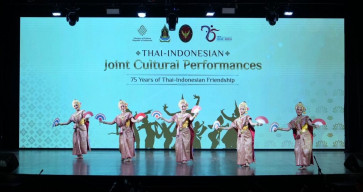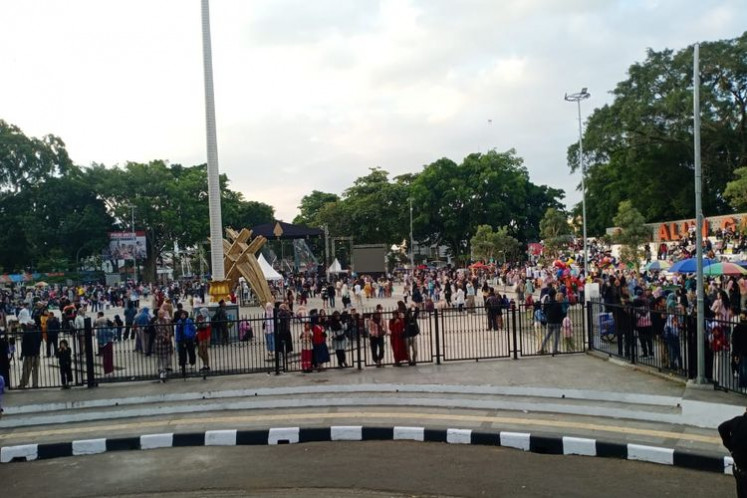Popular Reads
Top Results
Can't find what you're looking for?
View all search resultsPopular Reads
Top Results
Can't find what you're looking for?
View all search resultsWeekly 5: Rare fruit in Jakarta’s concrete jungle
Jakarta was once filled with fruit trees
Change text size
Gift Premium Articles
to Anyone
J
akarta was once filled with fruit trees. In fact, many areas in Jakarta were named after fruit trees or plantations, such as Kebon Jeruk (orange field) in West Jakarta, Duren Tiga (three durians) in South Jakarta, and Kampung Rambutan (rambutan village) in East Jakarta.
High-class areas were also named after fruits, such as Menteng in Central Jakarta and Kemang in South Jakarta. But because most of the backyard-farming land owned by the Betawi people has now been sold for urban development, although very rarely, these fruits can still be found.
(JP/P.J. Leo)Menteng
Menteng (Baccaurea racemosa) is similar in both appearance and size to duku (Lansium domesticum). In Central Java, menteng is known as mundung or kepundung. Menteng has a yellowish brown color and may turn gold as it becomes riper. It has a strong, sour taste although some are sweet. The meat is quite thin because of its big seeds.
The menteng fruit, once easily found in one’s backyard, has become rare due to the popularity of other fruits.
“I get my menteng supply from Bogor [south of Jakarta]. You can also find menteng at the Pasar Minggu traditional market [South Jakarta],” said a fruit vendor at Ragunan Zoo in South Jakarta who sells a bunch of menteng for Rp 7,500 (77 US cents).
Kemang
Kemang (Mangifera kemanga) is part of the mango family. It has a strong scent and a sweet taste.
Ripe kemang can be eaten or mixed with other kinds of fruit and ice. Some use young kemang as an ingredient in rujak (fruit salad). Kemang is grown and can still be found in Bogor.
(JP/P.J. Leo)Gowok
Gowok (Syzygium polycephalum) is also known as gohok to Betawi natives, kupa to Sundanese or dompyong to Javanese.
Gowok looks like a grape and tastes bittersweet. It is dark purple on the outside and white on the inside. Betawi natives refer to gowok as the fruit of women as they believe eating it will help increase fertility.
“It’s a seasonal fruit. You can’t find gowok all the time here,” said a Palmerah fruit vendor who buys gowok from Bogor and sells it for Rp 20,000 per kilogram.
Despite its rarity, gowok trees are commonly planted on green lanes along highways, in city forests and parks, like the National Monument park and the Indonesia miniature park’s bird park.
Jambu mawar
Jambu mawar (Syzygium jambos), or rose apple, was named after a flower for its strong rose scent. Ripe rose apple is yellowish, releases a strong scent and tastes both sweet and bittersweet, and has a bitter
aftertaste.
Rose apple trees used to stand tall in backyards, but are now hard to find. Imported rose apples may be available at supermarkets.
Bisbul
Bisbul (Diospyros blancoi) has red, velvety skin and sweet, tender meat with a strong scent. Bisbul is also called the butter fruit for its tenderness and creamy meat.
The taste of bisbul can vary. One may claim the bisbul they eat tastes like an apple, while another person may say it tastes like durian.
Some Bekasi residents still plant bisbul trees in their backyard, while it is easily found in Bogor. — JP

![(JP/P.J. Leo)" border="0" height="313" width="469"></span></strong><em><span class="inline inline-left"><span class="caption" style="width: 467px;">(JP/P.J. Leo)</span></span></em><strong>Menteng<br></strong><br>Menteng (Baccaurea racemosa) is similar in both appearance and size to duku (Lansium domesticum). In Central Java, menteng is known as mundung or kepundung. Menteng has a yellowish brown color and may turn gold as it becomes riper. It has a strong, sour taste although some are sweet. The meat is quite thin because of its big seeds. <br><br>The menteng fruit, once easily found in one’s backyard, has become rare due to the popularity of other fruits. <br><br>“I get my menteng supply from Bogor [south of Jakarta]. You can also find menteng at the Pasar Minggu traditional market [South Jakarta],” said a fruit vendor at Ragunan Zoo in South Jakarta who sells a bunch of menteng for Rp 7,500 (77 US cents). <br><br><strong>Kemang</strong><br><br>Kemang (Mangifera kemanga) is part of the mango family. It has a strong scent and a sweet taste. <br><br>Ripe kemang can be eaten or mixed with other kinds of fruit and ice. Some use young kemang as an ingredient in rujak (fruit salad). Kemang is grown and can still be found in Bogor. <br><strong><br><span class="inline inline-left"><img class="image image-img_assist_custom-470x313 " src="http://www.thejakartapost.com/files/images2/p10-gowok.img_assist_custom-470x313.jpg" alt="(JP/P.J. Leo)" title="(JP/P.J. Leo)](https://www.thejakartapost.com/files/images2/p10-menteng.img_assist_custom-470x313.jpg)









